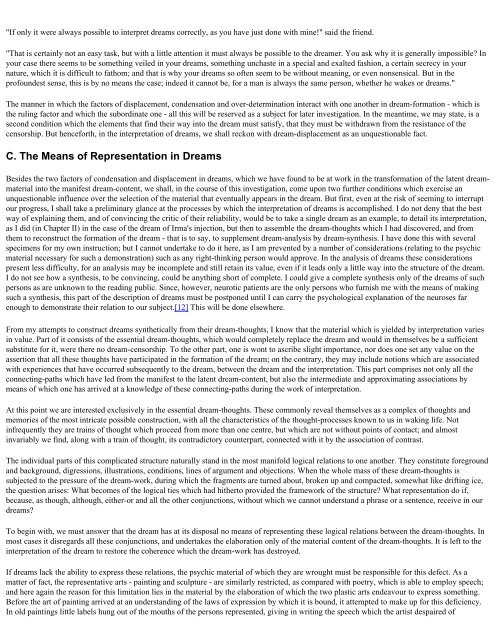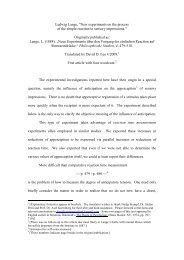The Interpretation Of Dreams Sigmund Freud (1900) PREFACE
The Interpretation Of Dreams Sigmund Freud (1900) PREFACE
The Interpretation Of Dreams Sigmund Freud (1900) PREFACE
You also want an ePaper? Increase the reach of your titles
YUMPU automatically turns print PDFs into web optimized ePapers that Google loves.
"If only it were always possible to interpret dreams correctly, as you have just done with mine!" said the friend.<br />
"That is certainly not an easy task, but with a little attention it must always be possible to the dreamer. You ask why it is generally impossible? In<br />
your case there seems to be something veiled in your dreams, something unchaste in a special and exalted fashion, a certain secrecy in your<br />
nature, which it is difficult to fathom; and that is why your dreams so often seem to be without meaning, or even nonsensical. But in the<br />
profoundest sense, this is by no means the case; indeed it cannot be, for a man is always the same person, whether he wakes or dreams."<br />
<strong>The</strong> manner in which the factors of displacement, condensation and over-determination interact with one another in dream-formation - which is<br />
the ruling factor and which the subordinate one - all this will be reserved as a subject for later investigation. In the meantime, we may state, is a<br />
second condition which the elements that find their way into the dream must satisfy, that they must be withdrawn from the resistance of the<br />
censorship. But henceforth, in the interpretation of dreams, we shall reckon with dream-displacement as an unquestionable fact.<br />
C. <strong>The</strong> Means of Representation in <strong>Dreams</strong><br />
Besides the two factors of condensation and displacement in dreams, which we have found to be at work in the transformation of the latent dreammaterial<br />
into the manifest dream-content, we shall, in the course of this investigation, come upon two further conditions which exercise an<br />
unquestionable influence over the selection of the material that eventually appears in the dream. But first, even at the risk of seeming to interrupt<br />
our progress, I shall take a preliminary glance at the processes by which the interpretation of dreams is accomplished. I do not deny that the best<br />
way of explaining them, and of convincing the critic of their reliability, would be to take a single dream as an example, to detail its interpretation,<br />
as I did (in Chapter II) in the case of the dream of Irma's injection, but then to assemble the dream-thoughts which I had discovered, and from<br />
them to reconstruct the formation of the dream - that is to say, to supplement dream-analysis by dream-synthesis. I have done this with several<br />
specimens for my own instruction; but I cannot undertake to do it here, as I am prevented by a number of considerations (relating to the psychic<br />
material necessary for such a demonstration) such as any right-thinking person would approve. In the analysis of dreams these considerations<br />
present less difficulty, for an analysis may be incomplete and still retain its value, even if it leads only a little way into the structure of the dream.<br />
I do not see how a synthesis, to be convincing, could be anything short of complete. I could give a complete synthesis only of the dreams of such<br />
persons as are unknown to the reading public. Since, however, neurotic patients are the only persons who furnish me with the means of making<br />
such a synthesis, this part of the description of dreams must be postponed until I can carry the psychological explanation of the neuroses far<br />
enough to demonstrate their relation to our subject.[12] This will be done elsewhere.<br />
From my attempts to construct dreams synthetically from their dream-thoughts, I know that the material which is yielded by interpretation varies<br />
in value. Part of it consists of the essential dream-thoughts, which would completely replace the dream and would in themselves be a sufficient<br />
substitute for it, were there no dream-censorship. To the other part, one is wont to ascribe slight importance, nor does one set any value on the<br />
assertion that all these thoughts have participated in the formation of the dream; on the contrary, they may include notions which are associated<br />
with experiences that have occurred subsequently to the dream, between the dream and the interpretation. This part comprises not only all the<br />
connecting-paths which have led from the manifest to the latent dream-content, but also the intermediate and approximating associations by<br />
means of which one has arrived at a knowledge of these connecting-paths during the work of interpretation.<br />
At this point we are interested exclusively in the essential dream-thoughts. <strong>The</strong>se commonly reveal themselves as a complex of thoughts and<br />
memories of the most intricate possible construction, with all the characteristics of the thought-processes known to us in waking life. Not<br />
infrequently they are trains of thought which proceed from more than one centre, but which are not without points of contact; and almost<br />
invariably we find, along with a train of thought, its contradictory counterpart, connected with it by the association of contrast.<br />
<strong>The</strong> individual parts of this complicated structure naturally stand in the most manifold logical relations to one another. <strong>The</strong>y constitute foreground<br />
and background, digressions, illustrations, conditions, lines of argument and objections. When the whole mass of these dream-thoughts is<br />
subjected to the pressure of the dream-work, during which the fragments are turned about, broken up and compacted, somewhat like drifting ice,<br />
the question arises: What becomes of the logical ties which had hitherto provided the framework of the structure? What representation do if,<br />
because, as though, although, either-or and all the other conjunctions, without which we cannot understand a phrase or a sentence, receive in our<br />
dreams?<br />
To begin with, we must answer that the dream has at its disposal no means of representing these logical relations between the dream-thoughts. In<br />
most cases it disregards all these conjunctions, and undertakes the elaboration only of the material content of the dream-thoughts. It is left to the<br />
interpretation of the dream to restore the coherence which the dream-work has destroyed.<br />
If dreams lack the ability to express these relations, the psychic material of which they are wrought must be responsible for this defect. As a<br />
matter of fact, the representative arts - painting and sculpture - are similarly restricted, as compared with poetry, which is able to employ speech;<br />
and here again the reason for this limitation lies in the material by the elaboration of which the two plastic arts endeavour to express something.<br />
Before the art of painting arrived at an understanding of the laws of expression by which it is bound, it attempted to make up for this deficiency.<br />
In old paintings little labels hung out of the mouths of the persons represented, giving in writing the speech which the artist despaired of



